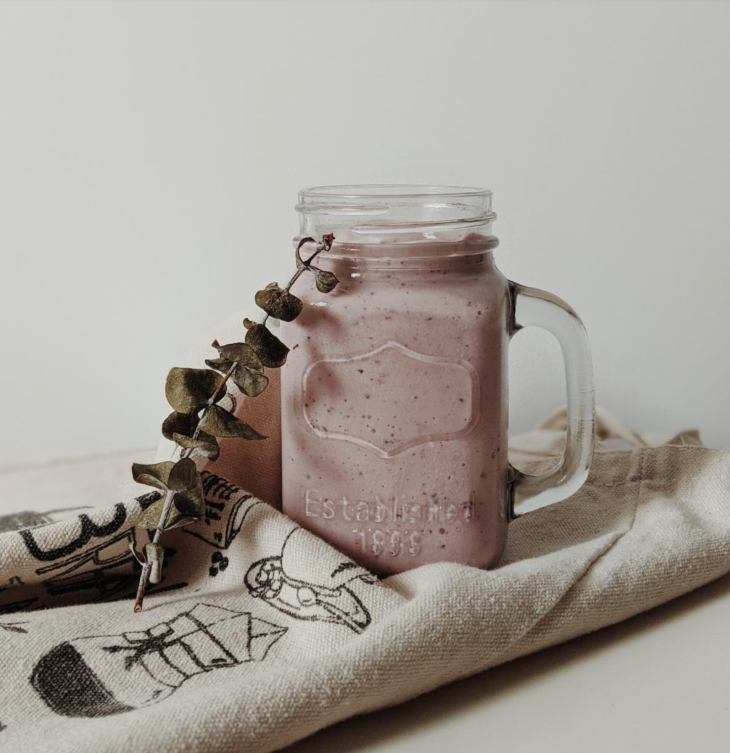Are you time poor or constantly on the run? We’ve got you covered with these quick and easy snacks that are super low in calories!
Here are our top 3 healthy snack recipes to kick those afternoon cravings!
Blueberry and Almond Protein Shake

Serves 1
Ingredients
Directions
Tip: Try adding some cinnamon to spice it up a little!
Chia Cacao Pudding

Serves 1
Ingredients
Directions
Sea salt and Garlic Kale Chips

Serves 4
Ingredients
Directions
By our Gym+Fitness team at PCYC Lang Park
While no one can guarantee perfect health in the future, making smart choices now can lead to a happier, healthier retirement. Like financial planning it requires many years of investment for a significant return of capital. Poor or risky investments result in low dividends or in most cases, no returns at all.
A safe fitness future might start with exercising 3 to 5 times a week for 30 years. With small adjustments over time, routines can be adapted even for those with limited mobility. Exercise benefits every age.
The following 10 tips are fitness investment strategies for a happier and healthier retirement. These positive lifestyle changes will help build that capital to hike, run, lift weights, and hold a plank!
Maintaining a healthy amount of muscle mass helps protect against physical weakness, which in turn reduces the risk of falls and other injuries. As we age, good balance depends on strong, well-controlled muscles. Muscle loss caused by inactivity or poor nutrition is often preventable, especially in the absence of underlying medical conditions. The good news is, it’s never too late to start exercising and build strength.
Avoid fad diets, yo-yo dieting, or any diet that excludes a whole food group. Remember your hydration too.
Resistance, Rugged, and Regular.
Resistance weight training affects the body like no other form of exercise. Force is exerted against the ligaments which in turn stimulate cells to lay down bone tissue, therefore maintaining bone density if nutrition is adequate. It also assists in reducing the effects of osteoporosis.
‘Rugged’ describes the intensity of your workout! You need to learn to exercise at an intensity that will provoke change. Sometimes, this needs to be determined by a health or fitness professional.
Regular: Three times a week for weights is optimal for a full body workout, twice is still OK, once a week is better than nothing, but the body will struggle to maximise the gains from training.
Bad posture (slouching, forward head posture, rounded shoulders) takes years to create changes which accommodate these bad habits. It is a mighty and daunting task to undo, and much easier to address them before postural change creates injury, gait issues, or chronic pain.
Give Dr Google a wide berth and realise that your friend’s physio program was tailored to them, not you! If you have a problem that is affecting your health or fitness, seek appropriate help.
Sleep needs change throughout life, so get as much sleep as your body needs.
Your doctor can monitor levels like cholesterol, liver enzymes, kidney function, and fasting blood sugar. Changes in these readings can show early signs of health problems. Catching these changes early makes them easier to manage, before they turn into serious illness. Sometimes, even a small change in your diet can make a big difference.
Exercise itself positively enhances mood, along with all the other great benefits. The social aspect of group fitness, whether indoors or outdoors helps provide diversity in life, combats isolation or loneliness, and helps create a network of peers in later life. Over 50’s exercisers frequently report that the social aspect of their weekly exercise is as important as the physical benefits.
Aerobic exercise can be done every day. To see improvement, the activity needs to be more challenging than a slow walk. For example, a brisk walk with some hills is more effective. You don’t have to run, aerobic just means “with oxygen.” It includes any activity that raises your heart rate and can be done for 30 minutes or more. The right intensity depends on the individual.
As we age, we naturally become less flexible, but regular stretching can help slow this down. Staying hydrated is also important to keep muscles and other tissues like tendons, ligaments, and joints healthy. Do dynamic stretches like leg swings before a workout to warm up and do static stretches after to help your muscles relax.
By our Gym+Fitness team at PCYC Beenleigh
Staying fit to keep up with our children is something we all must do. But what if you can keep fit with your kids? You’re getting in exercise; they’re burning all that energy and potentially need an early night. A win-win!
Physical activity improves overall physical fitness. By being active, your little ones develop cardiovascular endurance, flexibility, muscular strength, and muscular endurance, all while promoting agility and developing balance. Using the large muscles of the arms, legs, and body by crawling, running, and jumping, children hone ‘whole body movement’ skills which develop gross motor skills in a way like no other. The best thing we can do as parents is to be the best and healthiest version of ourselves.
By making time for our own exercise, making healthy food choices and demonstrating a positive attitude to our own body shape, we have a huge impact on our children. Although this is not always easy, it is truly the most effective and powerful road to take.
Doing a form of exercise as a family will build healthy habits in your child by getting active with them at a young age. You can all enjoy the health benefits mentioned above by working out together.
Bush/Beach walks
We are very lucky in Australia to be blessed with amazing treks inland, and kilometers of coastline to get those steps in. Maybe set a little challenge to see if you can do 1-3km as a family with a very light jog and go from there (A 7-year-old can average 15,000 steps a day so go that bit further).
Create your own mobile gym
A couple of towels, some basic weights, a resistance band or two and you’re set. The hardest part is deciding where to set the gym up. Is it going to be the park, near the beach, the garage at home or at a friend’s house where there is more equipment?
Swimming
Swimming is a life skill we all should have, but also is an awesome way to keep fit. See who can get the most lengths completed in a certain time or over the course of a month, to create a habit and some consistency in training.
Bike
A great family activity is going on a big bike ride and seeing where you end up. There are so many designated cycle tracks with picnic stops along the way, make a day of it and burn a good few hundred calories in the process.
Your children will make you accountable for staying active and moving, as you would for them. Keep all parties happy by doing a few things together and reap the rewards.
By our Gym+Fitness team at
The benefits of keeping our bodies fit and active as we transition into retirement not only have added social benefits but can also go a long way to support a more enjoyable and prolonged life. Exercise has been shown to prevent disease, lower the risk of falls, improve mental health and well-being, strengthen social ties and improve cognitive function.
You should aim for about 30 minutes of moderate-intensity physical activity every day. Moderate-intensity exercise should make you feel a bit breathless, but you should still be able to talk comfortably. Incorporate different types of physical activity into your daily routine. This will keep it interesting and easier to stick to over time.
If you are stuck for ideas please drop into your local PCYC Queensland Gym+Fitness Club and a member of the team will show you our Activ8 Fundamentals program. This program offers all Gym+Fitness members 4 to 12 weeks of support from qualified Trainers – free of charge!
By our Gym+Fitness team at PCYC Hills District
Exercise is often praised for its physical benefits, but its impact on mental health can be equally profound. Engaging in regular physical activity has been shown to have a positive effect on mental well-being, offering a holistic approach to mental health maintenance and improvement.
One of the most notable benefits of exercise on mental health is its ability to reduce stress and alleviate symptoms of anxiety and depression. When you exercise, your body releases endorphins, neurotransmitters that act as natural painkillers and mood elevators. These endorphins not only enhance your sense of well-being but also help to alleviate feelings of stress and anxiety, leaving you feeling more relaxed and at ease.
Exercise can also serve as a powerful distraction from negative thoughts and rumination. By focusing your attention on physical activity, you can temporarily shift your focus providing a much-needed mental break. This diversion can help break the cycle of negative thinking patterns and provide a sense of relief and clarity.
Regular exercise has also been linked to improved sleep quality, another crucial aspect of mental health. Sleep plays a vital role in regulating mood, cognition, and emotional well-being. By engaging in physical activity, you can promote better sleep patterns, helping you feel more refreshed and energised during the day.
Exercise offers opportunities for social interaction and connection, which are essential for mental health. Whether it’s joining a group training class, going for a walk with a friend, or participating in team sports; exercising with others can provide a sense of camaraderie and support. These social connections can help combat feelings of loneliness and isolation, fostering a sense of belonging and community. If you have a club with Activ8 Group Training nearby, give it a go and find a new workout buddy!
In addition to its immediate benefits, regular exercise can also have long-term effects on mental health. Research suggests that consistent physical activity may reduce the risk of developing certain mental health conditions, such as depression and anxiety disorders. By incorporating exercise into your daily routine, you can build resilience to stress and improve your overall psychological well-being over time.
Whether it’s a brisk walk, a yoga session, or a high-intensity workout, finding activities that you enjoy and that suit your lifestyle is key to maintaining a consistent exercise routine.
Exercise is a powerful tool for promoting mental health and well-being. By prioritising exercise as part of your self-care routine, you can cultivate a healthier mind and body, ultimately leading to a happier and more fulfilling life.
By our Gym+Fitness team at PCYC Ashmore
After your bundle of joy has arrived, you might be wondering when to start training again. First and foremost, please seek clearance from your doctor as to when it’s best to resume your fitness regime.
If you had a healthy pregnancy and a normal vaginal delivery, you should be able to start exercising again soon after the baby is born. Usually, it is safe to begin exercising a few days after giving birth—or as soon as you feel ready, but it is best to seek your doctor’s approval first. If you had a caesarean birth or complications, ask your ob-gyn when it is safe to begin exercising again.
Aim to stay active for 20 to 30 minutes a day. When you first start exercising after childbirth, try simple postpartum exercises that help strengthen major muscle groups, including abdominal and back muscles.
Gradually add moderate-intensity exercise. If you exercised vigorously before pregnancy or are a competitive athlete, you can work up to vigorous-intensity activity.
Remember, even 10 minutes of exercise benefits your body, but if you start to feel any pains, please stop exercising.
It’s best to avoid high-impact exercise such as running or cardio workouts until at least your six-week postnatal check so your body has time to recover from the birth.
Don’t push it
There may be pressure out there to “bounce back,” but your body has been through an experience it needs to rest and heal from, not be put through exercise boot camp. Often, your baby will not allow you to rest or recover, so don’t feel at all guilty to take every free minute to lie down or sleep. Feed yourself, shower, nap… Exercise does not need to be a priority in the first weeks after giving birth.
Start small
Think a walk around the block, for your first time back to introducing movement into your life. You have to get to know your new body shape and abilities postpartum while also balancing your fatigue. Take a walk, lift half a kilo weight, or tin of spaghetti in front of the TV, or do some stretching on the floor to start. Build up at your own pace.
Listen to your body
Listen to your body. If you get tired, take a break. If you have the energy or feel that some exercise could give you some energy, try it. You could injure yourself trying too much too soon, so keep taking mental stock of how you are physically feeling. If you experience higher than usual bleeding this could mean you’ve pushed yourself too far and need to reel it back.
Involve your baby
Take your baby on a stroller walk or jog or take a walk while babywearing. Lift your baby up and down 10 times in a row as if they were a weight. Put them on the floor next to you while you do yoga. This will let you exercise for longer since you won’t have to stop to take care of their needs – they’ll already be there. Plus, it’s a nice time to bond.
Set realistic goals
The number on the scale isn’t the most effective measure of health. Set goals like being able to touch your toes, lifting your baby without your back aching, being able to walk or run for 5 minutes longer than yesterday, and other milestones unrelated to weight.
Whether you want to work on self-care, feeling more yourself again, flexibility, strength, or another fitness goal, celebrate the wins when you reach your target. Reward yourself with a book, a bath, or a treat—whatever makes you feel good—when you reach those achievements.
Postpartum fitness doesn’t have to be a chore. Make it fit with your new lifestyle by incorporating your new baby and respecting the limits of your body as you go. You’ll be able to build up to more and more over time, but there’s no need to rush. Focus on your health instead of weight loss and be gentle with yourself as you go at your own pace.
All of the information above is written in line with the AUSactive guidelines.
Easter is fast approaching which means there is a LOT of chocolate everywhere you look! We know it’s so tempting to grab some choccies during the holidays. Below are a few healthy recipes you can add into the mix while still enjoying a chocolate egg or two. These were made and ‘tested’ by our very our PCYC Lang Park team and YUM! 🙂
Bunny Lover Carrot and Banana Muffins

Serves 6
Ingredients
Directions
Recipe provided by Woolworths
Carrot Garden Hummus Pots

Serves 3
Ingredients
Directions
Easter Potatoes

Serves 4
Ingredients
Directions